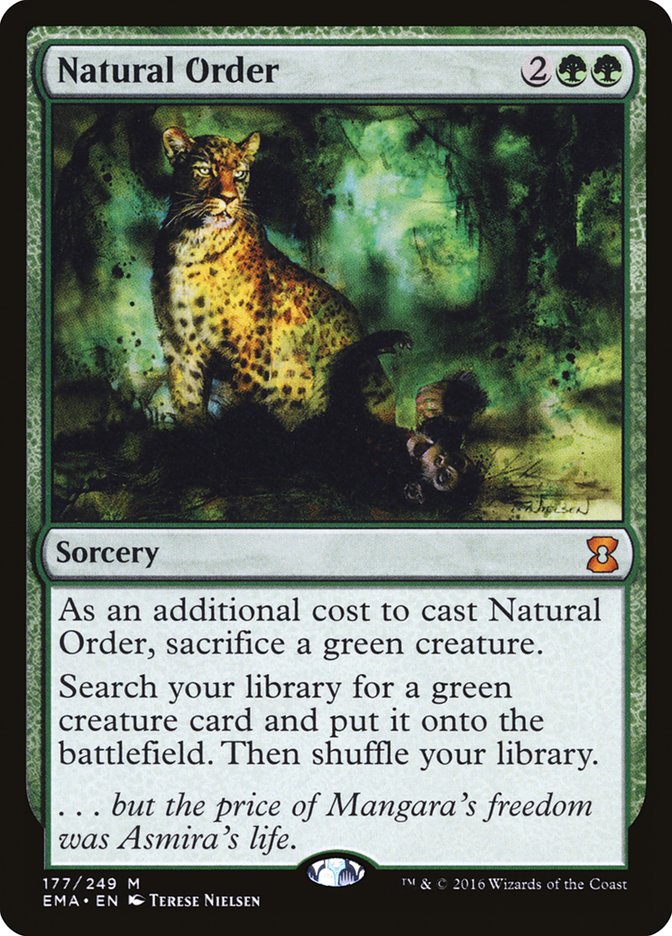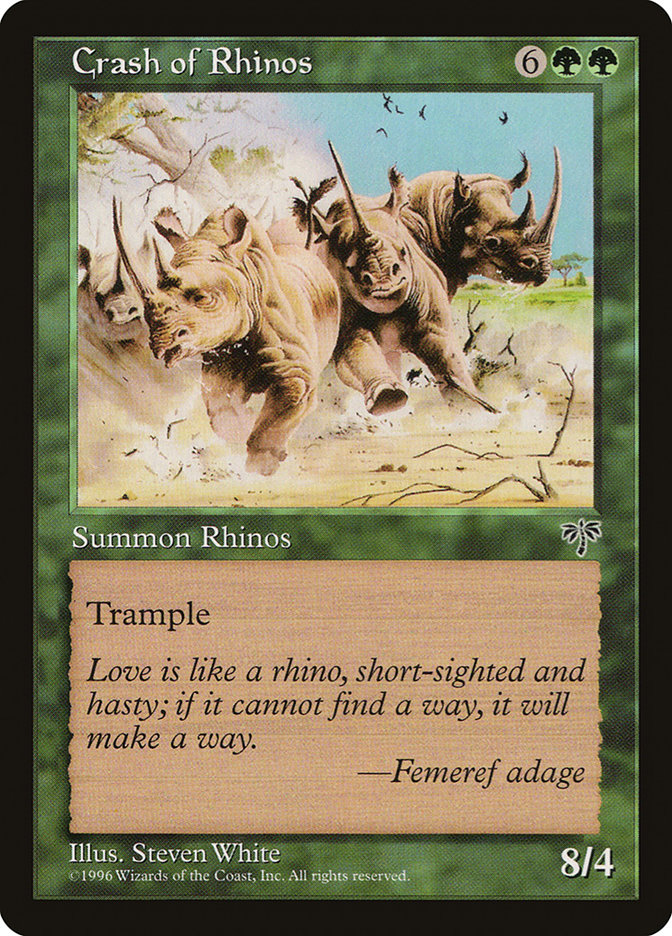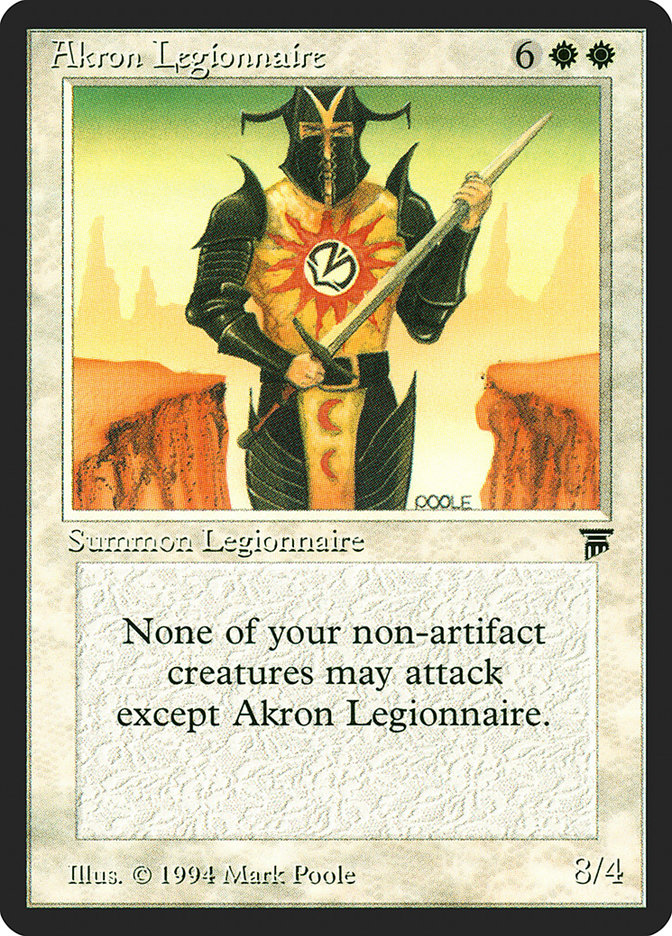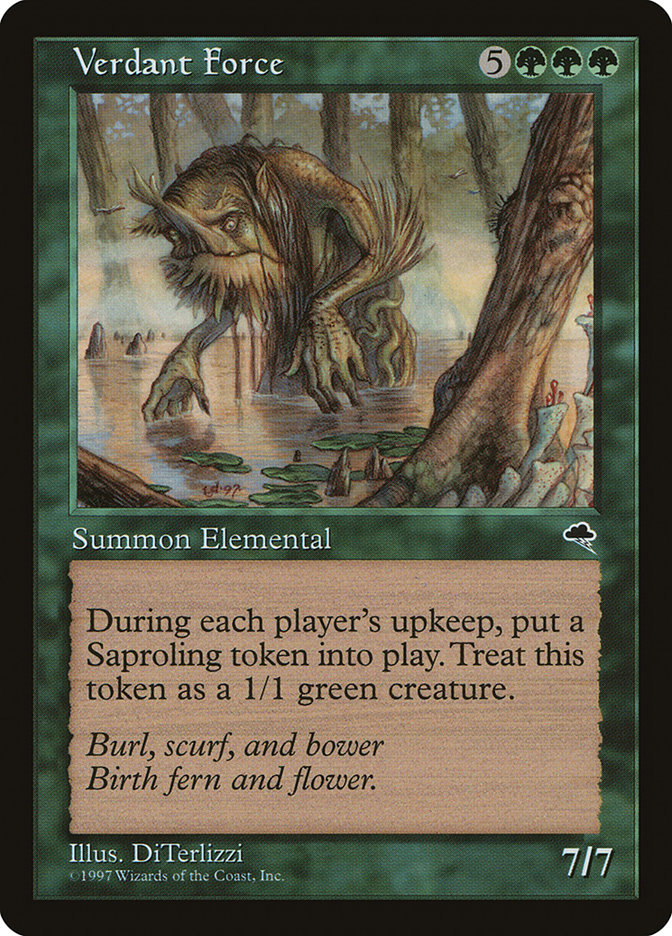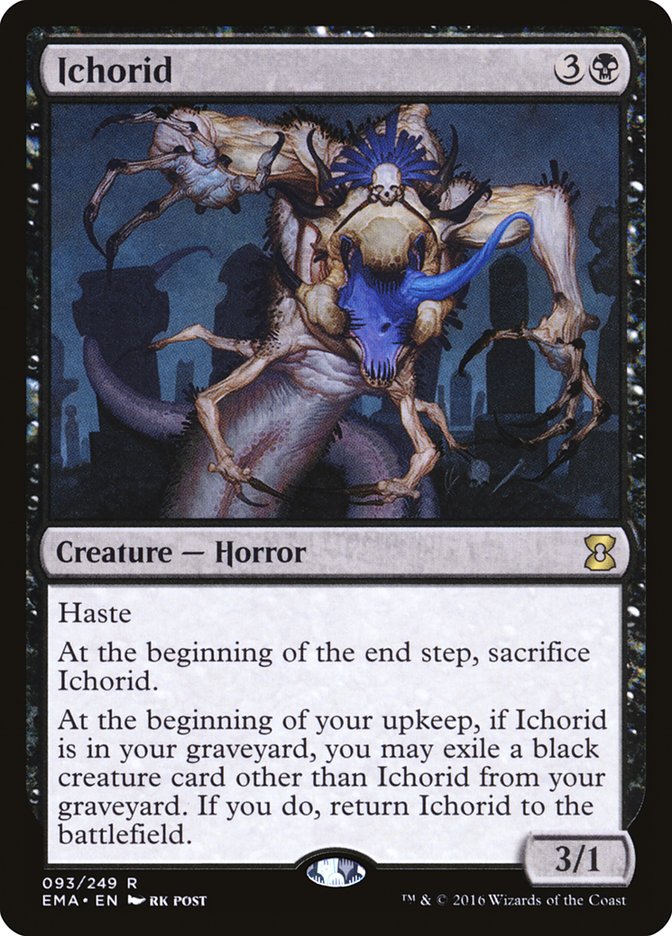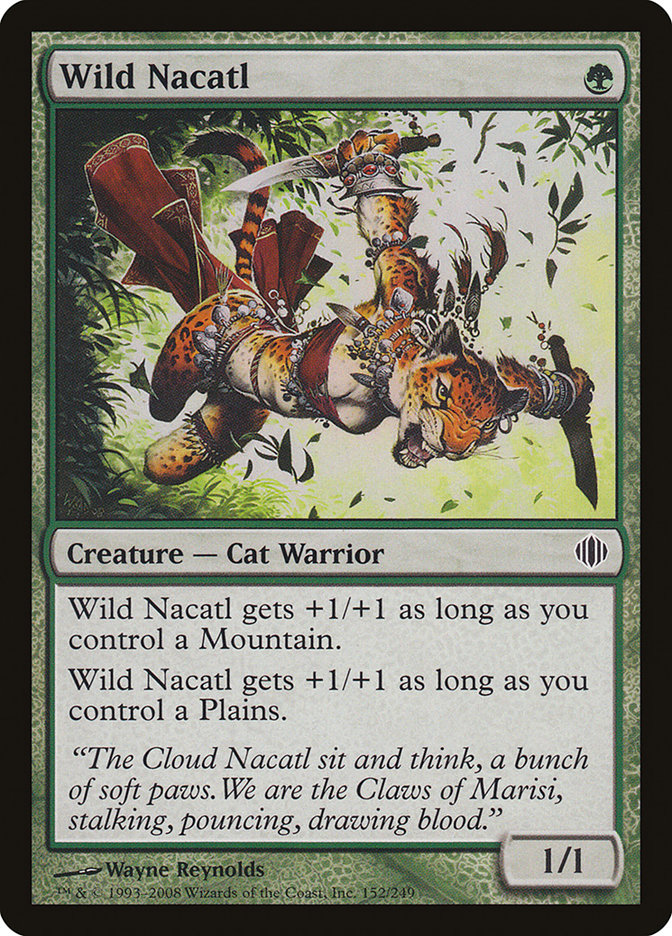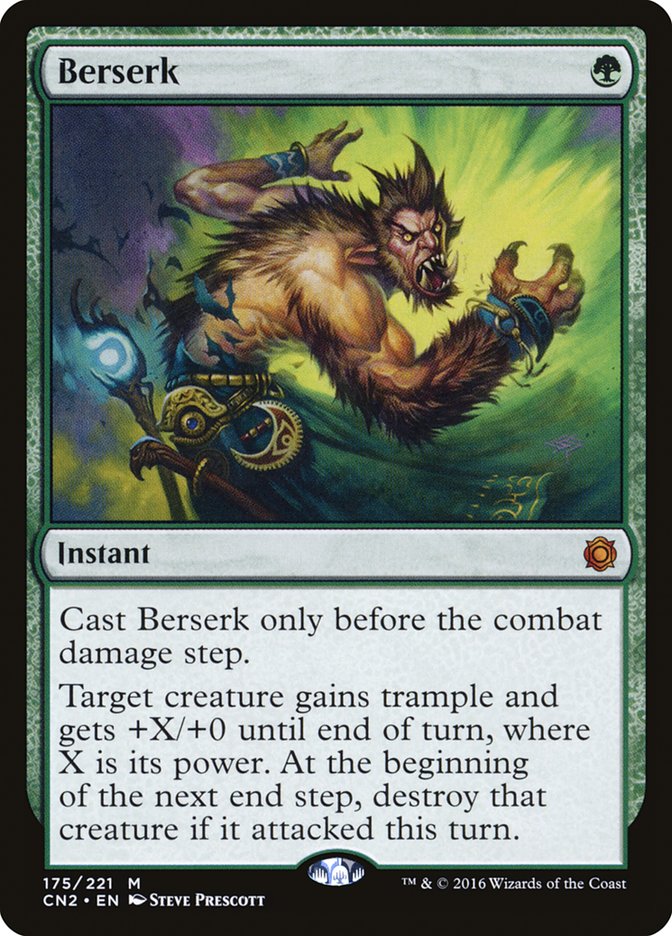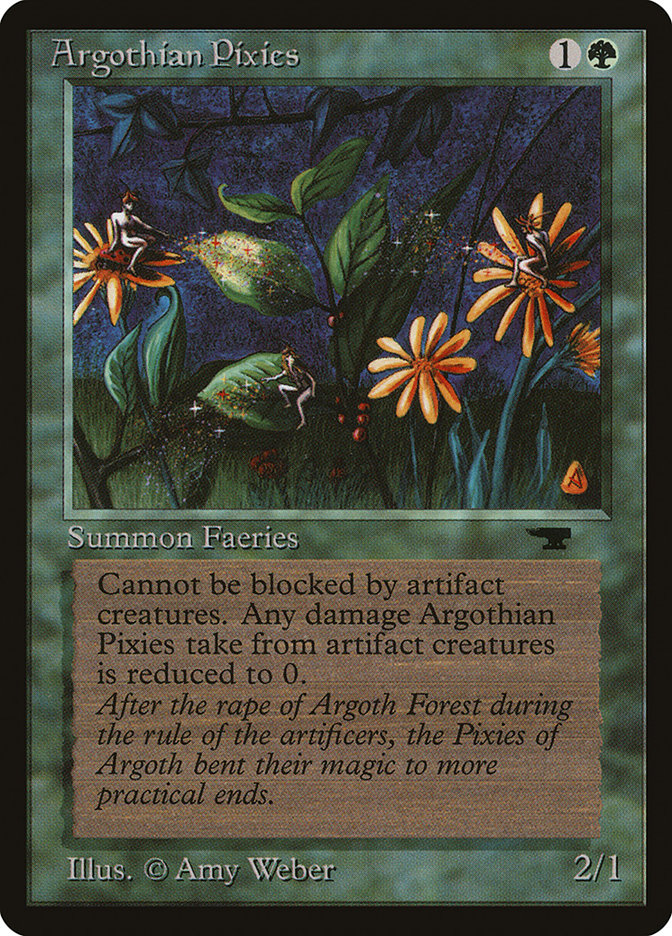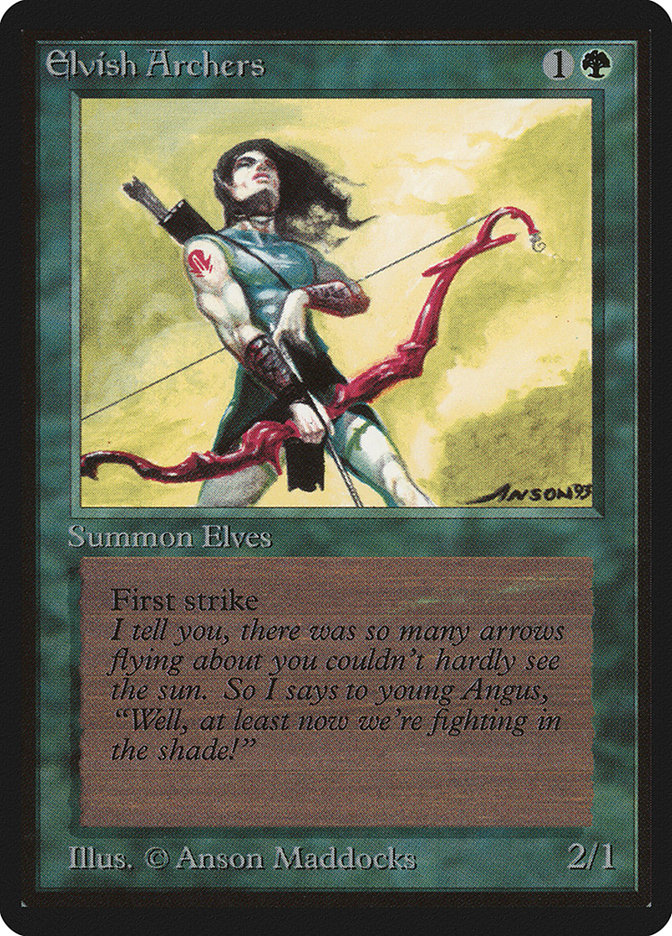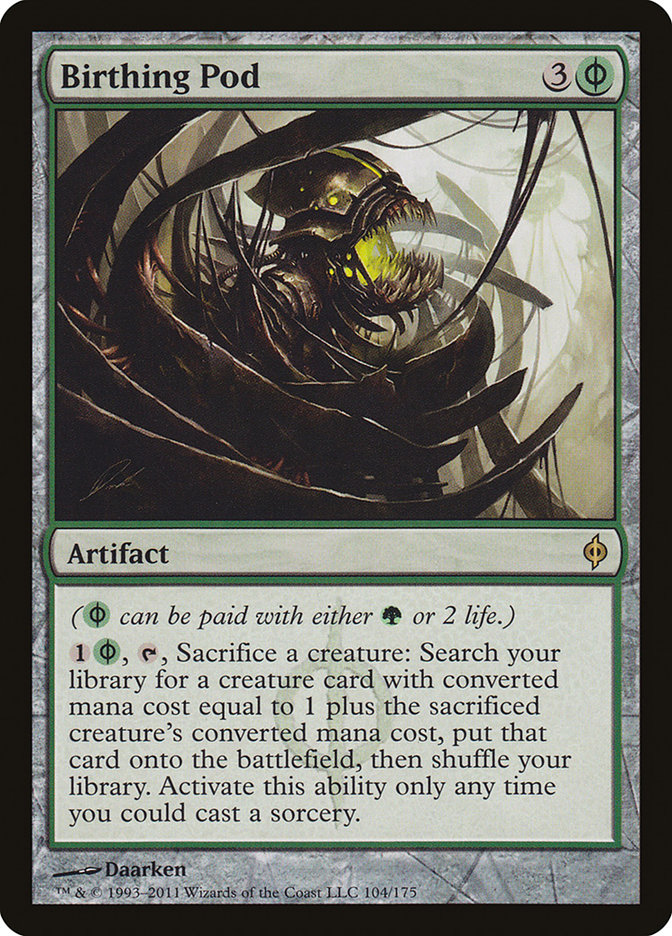A lot can change in 25 years.
Green has been good for so long, I wouldn’t be surprised if most of today’s players didn’t realize that green was famously considered the weakest color by a large margin in the early days of competitive Magic, a reputation that persisted for many years.
Even as late as Lorwyn, green was still seen as being slightly behind the other colors in enough of the hearts and memories of players. The first wave of planeswalkers included Garruk Wildspeaker, designed to make green’s planeswalker a reasonable candidate for being the best, to help rebrand green and send a message about the future of the color.
Still, green had its fair share of high points, even in the early days, as we’ll be seeing as we continue the Top 25 green cards of all time, with #20-#16, picking up where we left off.
#20: Natural Order
Natural Order was designed for the era before Wizards of the Coast started pushing huge creatures. When the card was first revealed in Mirage, it saw next to zero play. After all, when the best creature to find is Crash of Rhinos…
It’s like an Akron Legionnaire, except all upside!
The following year, however, Tempest brought the original “Best Fatty of All Time,” Verdant Force.
Finally, a fatty that could actually take over a game. Remember, this is an era where Alan Comer was casting Animate Dead on Shivan Dragon…because that was just the best creature to cheat onto the battlefield.
One of the godfathers of Magic writing, Jamie Wakefield, famously championed his Mono-Green Secret Force, for extremely hip battling with Natural Order fueling Turn 3 Verdant Forces.
Creatures (27)
- 4 Llanowar Elves
- 2 Spike Weaver
- 3 Verdant Force
- 3 Uktabi Orangutan
- 4 Spike Feeder
- 3 Elvish Lyrist
- 4 Fyndhorn Elves
- 4 Wall of Roots
Lands (6)
Spells (27)

It’s kind of amazing to look at this list now, with the benefit of twenty years of history. Nowadays, we take for granted the implications of eight one-drop accelerators on mana curves, green decks featuring flexibility instead of just being Stompy beatdown decks, and the use of Natural Order to let a “stupid green deck” function like a combo deck.
#19: Golgari Grave-Troll
There have been a lot of messed-up Dredge decks, and no card with Dredge is as messed up as Golgari Grave-Troll. Dredge 6? The Grave-Troll could have been a 0/0 and it would have seen just as much play…
Golgari Grave-Troll and other Dredge creatures being used to fuel a dedicated Dredge strategy was first proposed by John Rizzo, who envisioned using a critical mass of Dredge cards to allow him to quickly cycle through his deck and finding Ichorids.
If you’ve got some time and a twisted sense of humor, Rizzo wrote plenty about the strategy when he was first proposing it, and he’s a helluva writer. Here’s an early proposed list:
Creatures (25)
- 4 Psychatog
- 2 Putrid Imp
- 4 Mesmeric Fiend
- 4 Ichorid
- 2 Dark Confidant
- 2 Dimir Infiltrator
- 3 Golgari Grave-Troll
- 1 Golgari Thug
- 3 Stinkweed Imp
Lands (19)
Spells (16)

Remember, this was before people thought about Dredge as being a mechanic that lets you skip your draw steps in order to rebuy cards you’re not going to play. This was the first “Dredge” deck, the first to truly break the mechanic.
Players like Michael J. Flores helped tune the list, and a short time later, it began a long and illustrious career of GP domination. Michael Krumb’s GP Charlotte 2005 winning list paints the picture well:
Creatures (22)
Lands (18)
Spells (20)
Sideboard

Few cards have been involved in as much evil and just plain “not playing Magic” as Golgari Grave-Troll. Not only was the card banned in Modern for a while, it was a part of one of the most “not real Magic” decks in the game’s history: Legacy Manaless Dredge.
Creatures (44)
Spells (16)
Sideboard

Yeah……
#18: Wild Nacatl
While Kird Apes and the like have enjoyed a lot of success over the years, actual Wild Nacatl took things to another level. The card enjoyed immediate success in Modern, revolutionizing Zoo strategies, most notably Pro Tour Austin-winning Rubin Zoo.
Creatures (21)
- 4 Tarmogoyf
- 4 Wild Nacatl
- 3 Noble Hierarch
- 4 Knight of the Reliquary
- 3 Qasali Pridemage
- 3 Baneslayer Angel
Planeswalkers (1)
Lands (21)
Spells (17)
Sideboard

Brian Kibler, one of the game’s all-time great deck designers, piloted this take on Zoo that was the brainchild of another of the game’s all-time great deck designers, Hall of Famer, Ben Rubin. Since everyone knew Wild Nacatl was amazing, he wanted to build a Wild Nacatl deck that beat other Wild Nacatl decks.
This idea of slowing a Zoo deck down and going bigger was fairly revolutionary, spawning countless derivatives and now just being considered its own archetype, even to this day. For instance, Michael J. Flores’s Naya Lightsaber deck borrowed heavily from this strategy, helping propel Andre Coimbra to a World Championship title, showing Wild Nacatl could compete even without shocklands.
Creatures (25)
- 4 Ranger of Eos
- 4 Wild Nacatl
- 4 Woolly Thoctar
- 4 Noble Hierarch
- 4 Bloodbraid Elf
- 4 Baneslayer Angel
- 1 Scute Mob
Planeswalkers (3)
Lands (13)
Spells (19)
Sideboard

#17: Berserk
Berserk is a true classic, appearing on the literal first Restricted List in Magic, all the way back in January 1994, when the game was barely six months old (and during a time where there were approximately as many players worldwide as there are in California today).
Why was it restricted?
Well, playing two was basically game over!
After all, a Turn 2 Argothian Pixies or Elvish Archer followed by a Giant Growth and two Berserks is the natural twenty.
Yeah, things were a lot different in 1994.
Nevertheless, Berserk’s restriction didn’t stop the degenerate decks built around it from enjoying some success. For instance, Mark Rosewater (yes, that Mark Rosewater) lost one round short of finishing in the Top 64 at the very first Magic World Championship with the following Berserk deck:
Creatures (20)
Lands (9)
Spells (31)

And people wonder why Mark loved Infect so much…
Mark’s been a face of design for so long, I think most players don’t realize that he’s actually a very good player. We’re not talking Owen Turtenwald or Jon Finkel good, but definitely legit pro level, which never ceases to surprise people who join Wizards of the Coast R&D expecting him to be a casual player.
Berserk was, of course, eventually unrestricted in Vintage, as well as being legalized in Legacy. While the card didn’t do much for a number of years, eventually the infect mechanic reinvigorated the card.
Creatures (12)
Lands (18)
Spells (30)

#16: Birthing Pod
One of the most notorious cards to ever be banned, Birthing Pod’s power level was definitely extremely high, but I think its banning bothered a lot of people for two big reasons.
1. Banning it was perceived to kill a very cool and different archetype, soft-banning a lot of unusual cards.
2. It was actually better the year before but got caught up in Treasure Cruise and Dig Through Time getting banned. The idea of banning it when it wasn’t at a high point raised a lot of eyebrows.
While there have been many cool Birthing Pod decks at various points, the final nail in the coffin was Erik Peters’s Grand Prix Omaha 2015 list, one of many big GP finishes for Pod near the end of its Modern Career:
Creatures (29)
- 4 Birds of Paradise
- 1 Eternal Witness
- 3 Wall of Roots
- 1 Orzhov Pontiff
- 1 Shriekmaw
- 1 Reveillark
- 3 Kitchen Finks
- 1 Murderous Redcap
- 2 Noble Hierarch
- 1 Linvala, Keeper of Silence
- 1 Scavenging Ooze
- 2 Restoration Angel
- 1 Sin Collector
- 3 Voice of Resurgence
- 1 Reclamation Sage
- 3 Siege Rhino
Lands (19)
Spells (12)

While some Pod decks focused on assembling intricate combos, this build is a great example of the “value” approach, primarily focusing on exploiting enters-the-battlefield and death triggers while making extremely good use of the toolbox Birthing Pod enables.
Birthing Pod, like Necropotence, was a thing of beauty when we were innocent. However, like Necropotence, it was eventually pushed to such a degenerate place that fewer and fewer games were actually interesting when it was on the table.
Repeatable tutoring, turn after turn, proved too good? Who would have guessed…?


